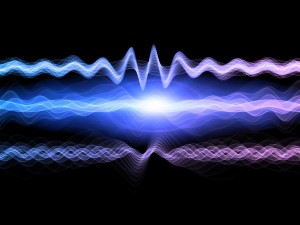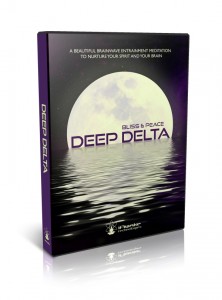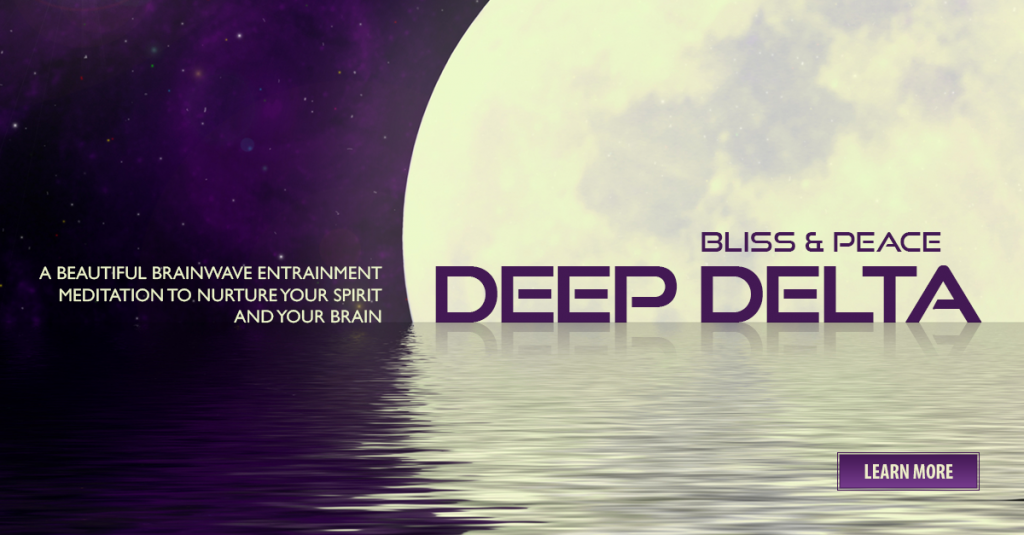How You Can Entrain Your Brain & Your Body to Deep Delta States
Learn how you can naturally entrain your brain and your body to deep delta states by listening to psychoacoustic music in this interview with Leigh Spusta, one of iAwake’s new producers. iAwake CEO John Dupuy and Leigh discuss the benefits of “natural entrainment,” deep delta — which can bring you into profound states of relaxation, bliss, and joy, and also the rejuvenating rewards of a deep sleep — and much more.
John: Welcome, everybody! We have a really special program today—Leigh Spusta, one of iAwake’s brilliant new producers of entrainment technology, is here with us. Leigh is an excellent musician, and he actually plays all the instruments himself, so there’s a lot of artistry, a lot of science, and a lot of beauty in his compositions. Leigh, can you tell us a little about your background and how you became interested in music and natural brainwave entrainment?
Leigh: Sure. I’d trace it back to being about 12 years old and taking up the guitar for the first time—playing music, learning songs, and whatnot. As I learned more and more throughout my teenage years, a theme started to develop that music is not only fun and sounds good, but it alters us; it can shift our moods. I was interested in spirituality and altered states of consciousness, and it all came together.
 Around 1997, I realized the direction I wanted to take and ended up at the HMI College of Hypnotherapy, where I came across brainwave entrainment—in particular, binaural beats. I studied the science behind it, how it works, and then I started experimenting. I ended up building what’s called a sound table. It’s like a bed that you lay on, and it’s got subwoofers mounted into it. When you play frequencies, especially low, vibro-acoustic, drone-like frequencies through it, it not only entrains your mind but also your body as well. So that was like a launching pad for me.
Around 1997, I realized the direction I wanted to take and ended up at the HMI College of Hypnotherapy, where I came across brainwave entrainment—in particular, binaural beats. I studied the science behind it, how it works, and then I started experimenting. I ended up building what’s called a sound table. It’s like a bed that you lay on, and it’s got subwoofers mounted into it. When you play frequencies, especially low, vibro-acoustic, drone-like frequencies through it, it not only entrains your mind but also your body as well. So that was like a launching pad for me.
John: That might explain why this technology seems to be so effective in releasing trauma from the past somatically, because it effects not just your brain but your whole body.
Leigh: Yes, absolutely. I think it’s an important component that is sometimes overlooked. It’s not just sound traveling through your ears, triggering your brain to do what’s called a frequency following response, or that our moods are being triggered, coached, and guided by the musical landscape. Rather, there’s a definite kinesthetic cellular experience that, even with headphones, is translated into the body—and especially if we play it through speakers with a decent bass response, basically every cell in our body is vibrating and it’s hard to resist going with that. That was a big eye-opener for me to really dig into that and have that experience.
Since then, I’ve been accumulating experience, data, research, testimonials from people, and crafting and fine-tuning different tracks. The last one was Deep Delta, and we had such great feedback on that. It’s been amazing.
John: Is there anything you’d like to say about the work you did producing Deep Delta? I could certainly say a lot about it from a phenomenological aspect—from somebody who’s using it. But please tell us about what your intention was, how you did it, and anything else you’d like to add.
Leigh: Sure. Well, I came to the point where I realized I had a lot of alpha to theta-orientated tracks but not one for delta. When we’re asleep throughout the night, if we have a healthy sleep pattern, we get into a natural delta brainwave state, where our body is repairing itself, our cells are regenerating. A different set of neurochemicals is released—feel-good chemicals. It’s about rejuvenation. It’s about hitting reset on the body. It’s about being in a very calm and relaxed state. There’s a myriad of benefits there that I was hoping to tap into.
Part of my composing approach is what I call “natural entrainment,” which is when you compose the music by first getting some of the math out of the way—so you know what the musical value or the frequency values of the notes of the music are in the beginning—and then when you reduce it down, you can actually get down to the naturally occurring monaural beats and also some binaural beats that occur naturally in the music. So when I sit down to work on a new track, after doing some of the math and getting that out of the way, it becomes very intuitive. I get into a creative space and go into a meditative type of trance myself and explore with the sounds until they start to click. I had a good palate of sounds working on Deep Delta, and eventually I kind of just channeled it through, I suppose you could say.
 At first, I didn’t think it was going to be that dynamic. But my original intentions worked out, because when I went back to listen to it, I found I didn’t need to do anything else to it. It came out the way it needed to come out, because there are so many little ebbs and flows within it that it’s very soothing and relaxing, and can almost become background sound, like the sound of rain. You just need to strike a balance of keeping the mind interested but also allowing the experience to flow. The experience should be the focal point, not the music.
At first, I didn’t think it was going to be that dynamic. But my original intentions worked out, because when I went back to listen to it, I found I didn’t need to do anything else to it. It came out the way it needed to come out, because there are so many little ebbs and flows within it that it’s very soothing and relaxing, and can almost become background sound, like the sound of rain. You just need to strike a balance of keeping the mind interested but also allowing the experience to flow. The experience should be the focal point, not the music.
John: Exactly. For me, the sound becomes a kind of holding structure that allows me to achieve a context of deep stillness in my meditation. After a while, it’s just sound. It all becomes one field, and there I am.
Leigh: That’s really the bottom line: getting people to experience it for themselves. A lot of people don’t have the motivation, perseverance, or whatever it is to really get a meditation practice going, or self-hypnosis, or start doing these things on a regular basis, because we have an innate resistance to sitting still. That’s where natural entrainment music comes in so perfectly, because you find that you’re moving into these states so gently and easily, and it’s enjoyable! We ask ourselves, “Why wasn’t I doing this before? Why haven’t I done this more often?” Then you get into a stream in your life where you’re doing it more and more frequently, because it’s readily accessible, it feels good, opens us up, gets us balanced, let go of our stress… It really is a tool.
All you have to do is go along with it, in other words, be in a sitting or lying position and receptive to allowing the sound and rhythm carry you into deeper and more expanded states. That’s all you have to do—allow it to guide you. Unless we have access to a temple full of a hundred monks all chanting “Om,” it doesn’t really get more available or more potent than just press play, relax, and go with it.
John: Leigh, can you talk about the shifts that you’ve seen in your own consciousness and the way that you deal with your inner and outer worlds since you’ve been using and creating this technology?
Leigh: Sure. I’ll go back again to around 1997-98, when I was getting heavily into experimenting with sounds and had just started noticing that the long drones or the stretched-out notes, om-like sounds, by themselves have an impact. From within these states, I would always get a sense of expanded awareness, and it’s interesting because there’s an intelligence there that we tap into—whether it’s our higher self, the universe, who’s to say—but there’s something going on that we can get into resonance with when we’re using these sounds. Insights come up that move through our minds with a different type of clarity and perspective.
If, perhaps, I’m feeling some angst in a situation, I’m not sure what to do, maybe I’m feeling kind of stuck, I’ll go and lay down and just get into the music. And when I come out of it, I’ll see things differently and make adjustments. I do this not with the expectation that I’m going to figure something out just because I’m listening to these sounds, but rather that there is an intelligence that becomes available when I’ve gotten into these relaxed, expanded states. I’ve had some profound insights that I didn’t expect at all.
 To me, the most exciting part is this whole other side of it. We open ourselves up to experience, to insight, to connectedness with the universe, to a greater self-understanding. These are really the experiences that are so necessary for people, and yet hard for people to come across or to find and create in their own lives.
To me, the most exciting part is this whole other side of it. We open ourselves up to experience, to insight, to connectedness with the universe, to a greater self-understanding. These are really the experiences that are so necessary for people, and yet hard for people to come across or to find and create in their own lives.
John: In mainstream spiritual traditions or religions, they have forgotten about practice—contemplative practice, meditation, and deep, transformative prayer. Not just reciting prayers of service or whatever. There is a natural hunger in human beings to experience this stuff.
Leigh: Yes. Our mental chatter, self-defeating thoughts and beliefs, attitudes—whatever is going on with us—build up after a while, and it affects our lives; it affects every choice we make and the way that we feel about anything. Even if they’re not true or real, these fears and limiting beliefs act as filters for our every experience. When you allow yourself to expand your state with the help of the music, it’s like hitting reset. You get to calm back down, release the tensions in your body and your ego mind (or that conscious part of ourselves that, I mean, let’s face it, is always a bit uptight). Now it kind of relaxes and takes a side chair and lets something else take over. We become more in tune with the world, the universe, with ourselves, our experience, and come out of the experience with relaxation and calmness. It’s like an after glow. It stays with us a bit and affects how we go about our day, and you can see how, over time and with practice, that it can really make a big dent in changing the course of our lives in a good way.
John: Leigh, thank you so much. Hopefully, there will be many more releases with iAwake of your work, genius, and what you’re putting out there. You’re such a sweet guy, and it’s really been delightful getting to know you better and working with you.
Adapted from iAwake Technologies’ free, weekly teleconference call on January 28, 2015.
Join our weekly calls!
To receive information on how to join the weekly iAwake coaching calls that John leads, sign up for the free meditation download and you’ll be put on the email list. You can also access the phone-in information on our Teleseminar page.
* * * * * * * * * * * * * * * * * * * * * * * * * * * * * * * * * * * * * * * * * * * * * * *
 Leigh Spusta is a behavioral scientist, hypnotherapist, and Certified Therapeutic Imagery Facilitator specializing in the use of sound frequencies to produce deep, relaxing trance states. His work has become internationally recognized, enjoyed by thousands around the world. Leigh combines his talents as a musician and his knowledge of hypnosis and related states, to pioneer new approaches in creating rich, resonant soundscapes for greater efficacy in healing and meditative products. You can watch Leigh’s appearance on the Amazing Mind show, talking about brainwave states and hypnosis, below.
Leigh Spusta is a behavioral scientist, hypnotherapist, and Certified Therapeutic Imagery Facilitator specializing in the use of sound frequencies to produce deep, relaxing trance states. His work has become internationally recognized, enjoyed by thousands around the world. Leigh combines his talents as a musician and his knowledge of hypnosis and related states, to pioneer new approaches in creating rich, resonant soundscapes for greater efficacy in healing and meditative products. You can watch Leigh’s appearance on the Amazing Mind show, talking about brainwave states and hypnosis, below.
Leigh’s PsimatiX™ methods incorporate hemispheric synchronization, mind/body resonant entrainment, vibro-acoustic tones, psychoacoustics, hypnotic modality, rhythmic entrainment frequencies and ancient wisdom of sound. This multi-faceted approach delivers excellent results in producing deep physical relaxation and mind-expanding states of awareness such as are beneficial for hypnosis, meditation, rest and rejuvenation, spiritual pursuits, and exploration of self and consciousness.
* * * * * * * * * * * * * * * * * * * * * * * * * * * * * * * * * * * * * * * * * * * * * * *

John Dupuy is the CEO of iAwake Technologies and the founder of Integral Recovery, a holistic addiction treatment approach inspired by Ken Wilber’s Integral Model. He is also the author of the award-winning book Integral Recovery: A Revolutionary Approach to the Treatment of Alcoholism and Addiction (SUNY Press, 2013). As a pioneer in the use of brainwave entrainment in therapy and personal development, John has dedicated his life to helping others deepen their spiritual practice and transform their lives.
Leave a Comment
You must be logged in to post a comment.


Leave your comments below